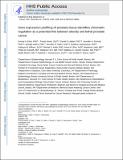| dc.contributor.author | Ebot, Ericka M. | |
| dc.contributor.author | Gerke, Travis | |
| dc.contributor.author | Labbé, David P. | |
| dc.contributor.author | Sinnott, Jennifer A. | |
| dc.contributor.author | Zadra, Giorgia | |
| dc.contributor.author | Rider, Jennifer R. | |
| dc.contributor.author | Tyekucheva, Svitlana | |
| dc.contributor.author | Wilson, Kathryn M. | |
| dc.contributor.author | Kelly, Rachel S. | |
| dc.contributor.author | Shui, Irene M. | |
| dc.contributor.author | Loda, Massimo | |
| dc.contributor.author | Kantoff, Philip W. | |
| dc.contributor.author | Finn, Stephen | |
| dc.contributor.author | Vander Heiden, Matthew G. | |
| dc.contributor.author | Brown, Myles | |
| dc.contributor.author | Giovannucci, Edward L. | |
| dc.contributor.author | Mucci, Lorelei A. | |
| dc.date.accessioned | 2018-11-07T15:50:16Z | |
| dc.date.available | 2018-11-07T15:50:16Z | |
| dc.date.issued | 2017-07 | |
| dc.date.submitted | 2017-05 | |
| dc.identifier.issn | 0008-543X | |
| dc.identifier.issn | 1097-0142 | |
| dc.identifier.uri | http://hdl.handle.net/1721.1/118939 | |
| dc.description.abstract | BACKGROUND: Obese men are at higher risk of advanced prostate cancer and cancer-specific mortality; however, the biology underlying this association remains unclear. This study examined gene expression profiles of prostate tissue to identify biological processes differentially expressed by obesity status and lethal prostate cancer. METHODS: Gene expression profiling was performed on tumor (n = 402) and adjacent normal (n = 200) prostate tissue from participants in 2 prospective cohorts who had been diagnosed with prostate cancer from 1982 to 2005. Body mass index (BMI) was calculated from the questionnaire immediately preceding cancer diagnosis. Men were followed for metastases or prostate cancer–specific death (lethal disease) through 2011. Gene Ontology biological processes differentially expressed by BMI were identified using gene set enrichment analysis. Pathway scores were computed by averaging the signal intensities of member genes. Odds ratios (ORs) for lethal prostate cancer were estimated with logistic regression. RESULTS: Among 402 men, 48% were healthy weight, 31% were overweight, and 21% were very overweight/obese. Fifteen gene sets were enriched in tumor tissue, but not normal tissue, of very overweight/obese men versus healthy-weight men; 5 of these were related to chromatin modification and remodeling (false-discovery rate < 0.25). Patients with high tumor expression of chromatin-related genes had worse clinical characteristics (Gleason grade > 7, 41% vs 17%; P = 2 × 10⁻⁴) and an increased risk of lethal disease that was independent of grade and stage (OR, 5.26; 95% confidence interval, 2.37-12.25). CONCLUSIONS: This study improves our understanding of the biology of aggressive prostate cancer and identifies a potential mechanistic link between obesity and prostate cancer death that warrants further study. | en_US |
| dc.description.sponsorship | National Institutes of Health (U.S.) (Grant P01 CA055075) | en_US |
| dc.description.sponsorship | National Institutes of Health (U.S.) (Grant R01 CA133891) | en_US |
| dc.description.sponsorship | National Institutes of Health (U.S.) (Grant R01 CA141298) | en_US |
| dc.description.sponsorship | National Institutes of Health (U.S.) (Grant R01 CA136578) | en_US |
| dc.description.sponsorship | National Institutes of Health (U.S.) (Grant R01 CA174206) | en_US |
| dc.description.sponsorship | National Institutes of Health (U.S.) (Grant UM1 CA167552) | en_US |
| dc.publisher | Wiley | en_US |
| dc.relation.isversionof | http://dx.doi.org/10.1002/CNCR.30831 | en_US |
| dc.rights | Creative Commons Attribution-Noncommercial-Share Alike | en_US |
| dc.rights.uri | http://creativecommons.org/licenses/by-nc-sa/4.0/ | en_US |
| dc.source | PMC | en_US |
| dc.title | Gene expression profiling of prostate tissue identifies chromatin regulation as a potential link between obesity and lethal prostate cancer | en_US |
| dc.type | Article | en_US |
| dc.identifier.citation | Ebot, Ericka M. et al. “Gene Expression Profiling of Prostate Tissue Identifies Chromatin Regulation as a Potential Link Between Obesity and Lethal Prostate Cancer.” Cancer 123, 21 (July 2017): 4130–4138 © 2017 American Cancer Society | en_US |
| dc.contributor.department | Koch Institute for Integrative Cancer Research at MIT | en_US |
| dc.contributor.mitauthor | Vander Heiden, Matthew G. | |
| dc.relation.journal | Cancer | en_US |
| dc.eprint.version | Author's final manuscript | en_US |
| dc.type.uri | http://purl.org/eprint/type/JournalArticle | en_US |
| eprint.status | http://purl.org/eprint/status/PeerReviewed | en_US |
| dc.date.updated | 2018-11-06T14:27:17Z | |
| dspace.orderedauthors | Ebot, Ericka M.; Gerke, Travis; Labbé, David P.; Sinnott, Jennifer A.; Zadra, Giorgia; Rider, Jennifer R.; Tyekucheva, Svitlana; Wilson, Kathryn M.; Kelly, Rachel S.; Shui, Irene M.; Loda, Massimo; Kantoff, Philip W.; Finn, Stephen; Vander Heiden, Matthew G.; Brown, Myles; Giovannucci, Edward L.; Mucci, Lorelei A. | en_US |
| dspace.embargo.terms | N | en_US |
| dc.identifier.orcid | https://orcid.org/0000-0002-6702-4192 | |
| mit.license | OPEN_ACCESS_POLICY | en_US |
